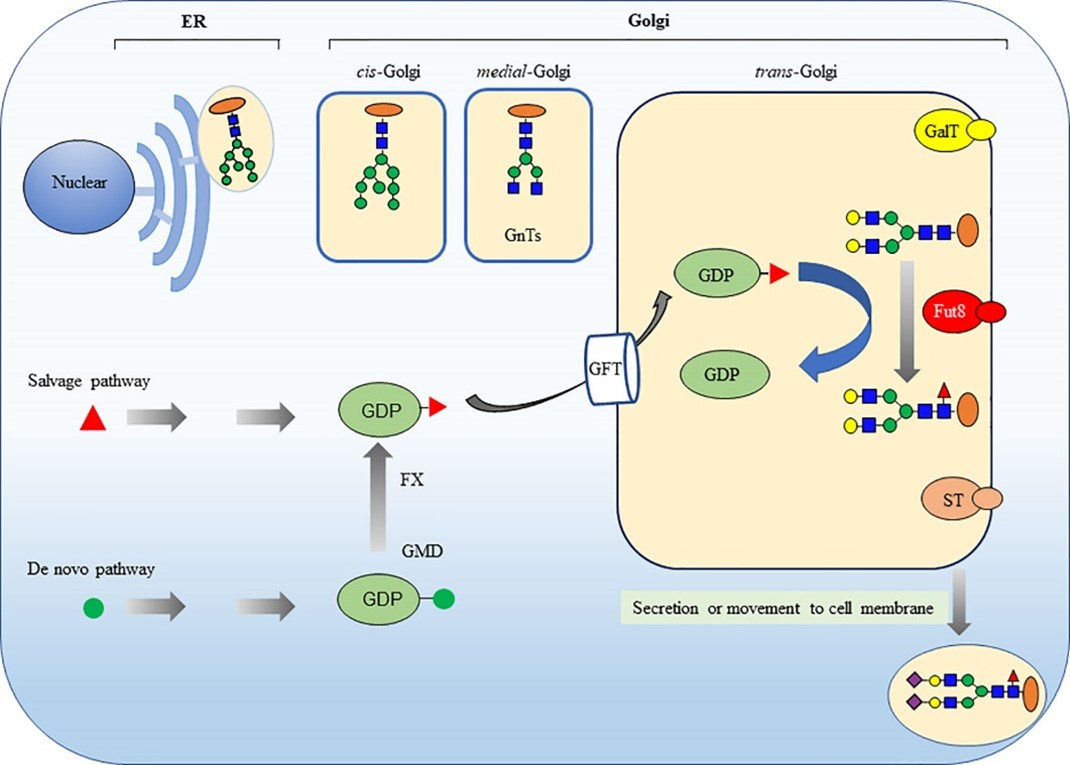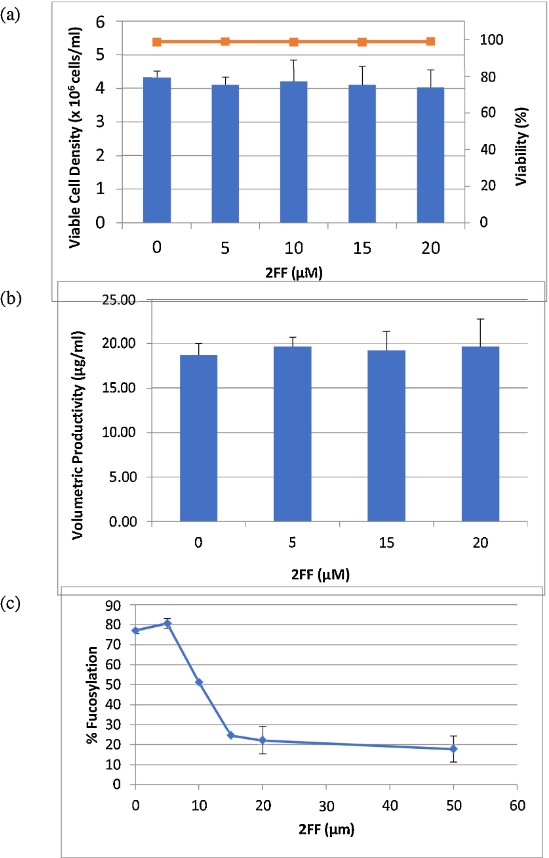Cell Glycoengineering by Manipulating Fucosylation
Core Fucosylation Pathway in Mammals
Core fucosylation is a widespread and significant characteristic of N-glycosylation. The core fucose is linked via an α-1,6 linkage to the innermost GlcNAc residue within the N-oligosaccharide. In mammals, FUT8 stands as the sole α-1,6 fucosyltransferase responsible for transferring fucose residues. GDP-fucose serves as the donor substrate for fucose transfer during glycosylation. The synthesis of GDP-fucose occurs in the cytoplasm through two distinct pathways: the de novo pathway and the salvage pathway. In the de novo pathway, GDP-mannose is converted by GDP-mannose 4,6-dehydratase (GMD). The salvage pathway involves the direct utilization of fucose. Subsequently, the cytoplasmic GDP-fucose is transported into the Golgi apparatus by the GDP-fucose transporter (GFT).
 Fig.1 Core fucosylation pathway in mammalian cells.1, 3
Fig.1 Core fucosylation pathway in mammalian cells.1, 3
Cell Glycoengineering by Manipulating Fucosylation at Creative Biolabs
Equipped with advanced platforms in Glycoengineering Services, Creative Biolabs provides multiple genetic interventions to manipulate fucosylation in diverse expression systems. We use various methods such as antisense cDNA, small interfering RNAs (siRNAs), or transgenic overexpression to inhibit or eliminate core fucosylation. To enhance the efficiency of gene disruption, technologies like TALENs and the CRISPR/Cas9 system are also modified in our laboratory to induce targeted genetic Knockout and Knockin. These modulations are mainly targeted at the following pathways.
Inactivation of FUT8
Knockout of FUT8 effectively prevents the synthesis of core fucosylated N-glycans.
Inactivation of GDP-fucose synthesis pathway or GFT
Knockout of GMD effectively disrupts the de novo pathway of GDP-fucose synthesis. And knockout of GFT yields non-fucosylated antibodies from mammalian cells.
Overexpression of β-1,4-N-acetylglucosaminyltransferase III (GnT-III)
GnT-III is responsible for adding bisecting GlcNAc onto the core structure of N-glycans, overexpression of GnT-III can generate a structure unsuitable for fucosylation.
In addition to genetic modulations in mammalian cells, we also provide services to modify fucosylation in Plant Cells and Insect Cells by conversion of non-mammalian N-glycosylation pathway into the mammalian type.
Glycoengineering for the Removal of Core Fucose: Applications and Benefits
The absence of core fucose has a significant impact on the efficacy and safety of therapeutic proteins. N-glycans containing fucose located at Asn297 in IgG antibody detrimentally influence the Fc-FcɣRIII interaction. Elimination of core fucose from human IgG enhances the binding affinity of the Fc domain to FcɣRIII and results in a remarkable increase of up to 100-fold in antibody-dependent cellular cytotoxicity (ADCC).
Advantages of Our Services
-
Optional genetic strategies for manipulating fucosylation
-
Cutting-edge technologies for precise genome editing
-
Effective manipulation of fucosylation across different expression systems
-
Professional team with extensive experience in glycoengineering
Published data
Scientists can perform specific modifications on glycans in cells through cell glycoengineering. In this study, the authors used antibodies as the research object and achieved the fucosylation modification of antibodies through two cell-glycoengineering strategies. They added suitable inhibitors, such as 2-fluoroperacetylated fucose, to the EG2-hFc cell culture medium, or they overexpressed genes related to fucose synthesis. In addition, the authors also used electrospray ionization mass spectrometry technology to determine the fucosylated glycan spectra generated by these two glycoengineering strategies. The analysis results showed that both glycoengineering strategies could achieve the desired level of antibody fucosylation.
 Fig.2 Effect of 2FF inhibitor on cell growth and fucosylation.2, 3
Fig.2 Effect of 2FF inhibitor on cell growth and fucosylation.2, 3
Creative Biolabs, as a leading company in the field of glycoengineering, has acquired extensive experience in fucosylation-targeted glycoengineering in various expression systems. To obtain more details, please don't hesitate to contact us or directly submit an inquiry.
Referencess
-
Sun, Yuhan, et al. "Core fucosylation regulates the function of pre-BCR, BCR and IgG in humoral immunity." Frontiers in Immunology 13 (2022): 844427.
-
Mishra, Neha, et al. "Comparison of two glycoengineering strategies to control the fucosylation of a monoclonal antibody." Journal of Biotechnology 324 (2020): 100015.
-
Distributed under Open Access license CC BY 4.0, without modification.
For Research Use Only.
Related Services

 Fig.1 Core fucosylation pathway in mammalian cells.1, 3
Fig.1 Core fucosylation pathway in mammalian cells.1, 3
 Fig.2 Effect of 2FF inhibitor on cell growth and fucosylation.2, 3
Fig.2 Effect of 2FF inhibitor on cell growth and fucosylation.2, 3



